Gebali F. Analysis Of Computer And Communication Networks
Подождите немного. Документ загружается.


10.6 Carrier Sense Multiple Access-Collision Avoidance (CSMA/CA) 349
former. This is due to the fact that CSMA/CA keeps transmitting frames even when
collisions have taken place. Therefore, precious bandwidth and time are wasted
transmitting frames while CSMA/CD stops the transmission promptly.
The access probability for a user in the CSMA/CA protocol is given by
p
a
=
Th
Na
(10.84)
Figure 10.12 shows the access probability of CSMA/CA when n = 50 and
N = 10. The solid line is the access probability of CSMA/CA, the dashed line
represents the access probability of slotted ALOHA, and the dotted line represents
the access probability of pure ALOHA.
The average energy required to transmit a frame is estimated as
E = E
0
∞
i=0
(i +1)(1 − p
a
)
i
p
a
=
E
0
p
a
(10.85)
where E
0
is the energy required to send one frame. In dB, the above equation can
be written as
E =−10 log
10
p
a
dB (10.86)
Figure 10.13 shows the average energy required to transmit a frame for the
CSMA/CA when n = 50 and N = 10. The solid line is the average energy of
Fig. 10.12 Access
probability of CSMA/CA
protocol versus the average
input traffic per time step for
the case n = 50 and N = 10.
The solid line is the access
probability of CSMA/CA, the
dashed line represents the
access probability of slotted
ALOHA, and the dotted line
represents the access
probability of pure ALOHA
0 2.5 5 7.5 10
0
0.2
0.4
0.6
0.8
1
Input traffic
Access probability
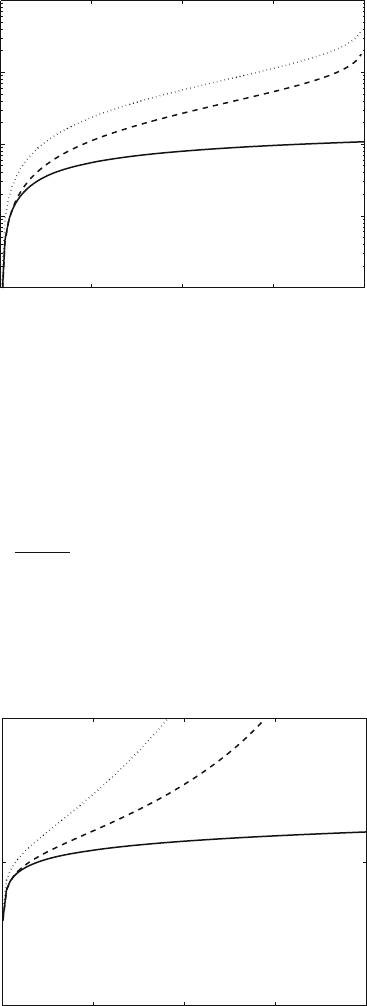
350 10 Modeling Medium Access Control Protocols
Fig. 10.13 Average energy to
transmit a frame for the
CSMA/CA protocol versus
the average input traffic per
time step for the case n = 50
and N = 10. The solid line is
the energy for CSMA/CA,
the dashed line represents the
energy for slotted ALOHA,
and the dotted line represents
the energy for pure ALOHA
0 2.5
10
–1
10
0
10
1
10
2
10
3
5 7.5 10
Input traffic
Energy (dB)
CSMA/CA, the dashed line represents the average energy of slotted ALOHA, and
the dotted line represents the average energy of pure ALOHA.
The average number of attempts for a successful transmission is
n
a
=
∞
i=0
i (1 − p
a
)
i
p
a
=
1 − p
a
p
a
(10.87)
Figure 10.14 shows the delay of the CSMA/CA protocol when n = 50, N = 10,
and p = 1. The solid line is the delay of CSMA/CA, the dashed line represents the
delay of slotted ALOHA, and the dotted line represents the delay of pure ALOHA.
Fig. 10.14 Frame delay for
the CSMA/CA protocol
versus the average input
traffic for the case n = 50
and N = 10. The solid line is
the delay of CSMA/CA, the
dashed line represents the
delay of slotted ALOHA, and
the dotted line represents the
delay of pure ALOHA
0 2.5
10
–5
10
0
10
5
5 7.5 10
Input traffic
Delay

10.7 IEEE 802.11: DCF Function for Ad Hoc Wireless LANs 351
10.7 IEEE 802.11: DCF Function for Ad Hoc Wireless LANs
A major advance in wireless communications is introduction of the IEEE 802.11
medium access control (MAC) and physical layer (PHY) standard. The specification
includes three sublayers of the physical (PHY) layer: a frequency-hopping spread-
spectrum (FHSS) physical layer, a direct-sequence spread-spectrum (DSSS) link
layer, and a diffused infrared layer [9, 10]. IEEE 802.11 wireless LAN standard is
used for infrastructure as well as ad hoc networks.
Infrastructure wireless networks have a central controller called access point
(AP) that coordinates medium access among the users. This part of the protocol is
referred to as point coordination function (PCF) and it occupies a short time period
at the start of each transmitted frame as shown in Fig. 10.15. The frame starts with
a point coordination function (PCF) period, which is a time period to enable pri-
oritized access for control messages and time-critical traffic [11–13]. This form of
centralized medium access scheme enables the IEEE 802.11 to offer some quality
of service (QoS) guarantees through implementation of a scheduling algorithm at
the AP.
AD hoc wireless networks do not have a central controller. Instead, each node or
user attempts to access the shared medium on its own. This part of the protocol is
referred to as distributed coordination function (DCF) and it follows the PCF period
of each transmitted frame as shown in Fig. 10.15. This is a form of distributed
reservation scheme that could provide statistical QoS guarantees.
10.7.1 IEEE 802.11: DCF Medium Access Control
The DCF MAC part of IEEE 802.11 standard is based on CSMA-CA (listen-before-
talk) with rotating backoff window [11]. When a node receives a frame to be trans-
mitted, it chooses a random backoff value, which determines the amount of time the
node must wait until it is allowed to transmit its frame. A node stores this backoff
value in a backoff counter. During periods in which the channel is clear, the node
decrements its backoff counter. (When the channel is busy it does not decrement
its backoff counter.) When the backoff counter reaches zero, the node transmits the
frame. Since the probability that two nodes will choose the same backoff factor is
small, collisions between frames are minimized. Collision detection, as is employed
in Ethernet, cannot be used for the radio frequency transmissions of IEEE 802.11.
The reason is that when a node is transmitting it cannot hear any other node in the
system which may be transmitting, since its own signal will drown out any others
arriving at the node.
Fig. 10.15 Location of PCF
and DCF periods in the frame
of IEEE 802.11 protocol
Point Coordination
Function Period (PCF)
Frame
Transmitted packet
Distributed Coordination
Function Period (DCF)
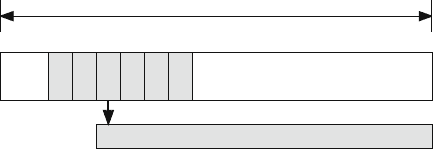
352 10 Modeling Medium Access Control Protocols
Fig. 10.16 DCF part of the
IEEE 802.11 frame
PCF/
SIFS
Backoff window
Frame
Transmitted packet
01 2 345
In that sense, 802.11 could be classified as CSMA/CA but with provisions for
reducing the chance of collisions through adoption of the reservation slots using the
backoff counters. The slots have the effect of ensuring that a reduced number of
users compete for access to the channel during any given reservation slot.
Figure 10.16 shows the DCF part of the IEEE 802.11 frame. After the PCF period
(i.e., SIFS), there is the DCF period (i.e., DIFS) which is a contention window that
is divided into reservation slots. The figure shows six such slots. The duration of a
reservation slot depends on the propagation delay between stations. The rest of the
frame is dedicated to transmitting the frames.
A station that intends to transmit senses if the channel is busy. It will then wait
for the end of the current transmission and the PCF delay. It then randomly selects
a reservation slot within the backoff window. The figure shows that a station in time
reservation slot 2 starts transmitting a frame since the channel was not used during
reservation slots 0 and 1.
Collisions occur when two or more stations select the same reservation slot. If an-
other station started transmission at an earlier reservation slot, the station freezes its
backoff counter and waits for the remaining content of this counter after the current
transmission ends. We consider the behavior of one user, which we term the tagged
user. Figure 10.17 shows the IEEE 802.11 MAC scheme as viewed by a certain user
(called the tagged user). Figure 10.17 indicates that the tagged user, as indicated
by the black circle, randomly selected reservation slot 7 to start transmission. So its
backoff counter contains the value 7 now. However, another user starts transmission
at reservation slot 2 as indicated by the grey box. Since the channel was quiet for two
reservation slots (slot 0 and 1), the backoff counter of the tagged user will contain
the value 5 at the end of the current frame.
Figure 10.17(b) shows the next frame. However, another user at reservation slot
1 started transmission. Since the channel was quiet for one reservation slots (slot
0), the backoff counter of the tagged user will contain the value 4 at the end of the
current frame.
Figure 10.17(c) shows the next frame. The tagged user is successful in starting
transmission since the channel was quite for four reservation slots (0, 1, 2, and 3).
10.7.2 IEEE 802.11: DCF Model Assumptions
In order to facilitate developing an analytical model for the 802.11 protocol, we
model the backoff counters in each station in terms of allocation to a reservation

10.7 IEEE 802.11: DCF Function for Ad Hoc Wireless LANs 353
Fig. 10.17 IEEE 802.11
MAC scheme
Tagged user
Transmitted packet
01234567
(a)
Transmitted packet
01234567
(b)
Transmitted packet
01234567
(c)
slot. Figure 10.18 shows the backoff window divided into w reservation slots. The
value of w equals the maximum value that can be stored in the backoff counter of
any user.
At the start of the frame, users in slot 0 sense that the channel is idle and are able
to start transmission. When that happens, all users in the other slots will sense that
the channel is busy and will refrain from transmitting their data. A collision could
happen if two or more users in slot 0 begin to transmit simultaneously. However,
the likelihood of this event happening is small since the number of users in slot 0 is
lesser than the total number of users.
If all users in slot 0 remain idle, then users in slot 1 can transmit if they have
frames to send. The same argument can be applied to the rest of the reservation
slots.
We employ the following simplifying assumptions:
1. Since the current state of the channel depends only on its immediate past his-
tory, we can model the channel using Markov chain analysis.
2. The states of the Markov chain represent the states of the channel: idle, trans-
mitting, and collided.
Fig. 10.18 Modeling the
backoff counters in IEEE
802.11 MAC scheme in terms
of w reservation slots
w-1
Start of frame
Contention window
012
...

354 10 Modeling Medium Access Control Protocols
3. There are N equal priority users in the network. By network, we mean a single-
hop network or the nodes within the transmission range of a particular node.
4. There are w reservation slots in the contention window.
5. The duration of one time step in the contention window is roughly taken equal
to the maximum expected propagation delay τ
p
plus the time it takes a station
to sense the presence of a carrier. This time is called the distributed interframe
spacing (DIFS).
6. The Markov chain time step is taken equal to the DIFS period.
7. The ratio of frame transmission delay to contention window delay is n > 1.
8. All frames have equal lengths such that a frame takes n time steps to be trans-
mitted.
9. Probability that an idle station receives a frame for transmission during a time
step is a.
10. A station can have at most one message waiting for transmission.
11. A user selects a time slot with the same probability.
12. Collided users use the same slot reservation protocol as uncollided users—i.e.,
collided users employ a random backoff strategy as opposed to binary exponen-
tial backoff strategy.
The probability that a user with data to send reserves a particular reservation slot
is given by
α =
1
w
(10.88)
Slot reservation requests are representative of incoming traffic. Therefore, the
user population seen by each slot in the contention window is given by
N
= α N =
N
w
(10.89)
The above equation indicates that the number of users that compete to access the
medium is reduced from N to N
. We expect therefore that the chance of collisions
is reduced compared to the case when there were no reservation slots.
The probability that k users attempt a transmission during a given reservation slot
is given by
u
k
=
N
k
a
k
(1 −a)
N
−k
;0≤ k ≤ N
(10.90)
Based on the above assumptions, the 802.11 channel could be in one of three
states: idle, collided,ortransmitting. Figure 10.19 shows the transition diagram for
our Markov chain. In the figure, the channel stays in the idle state with probability
x, which is the probability that all users do not have frames to send. The probability
x for this event is given by
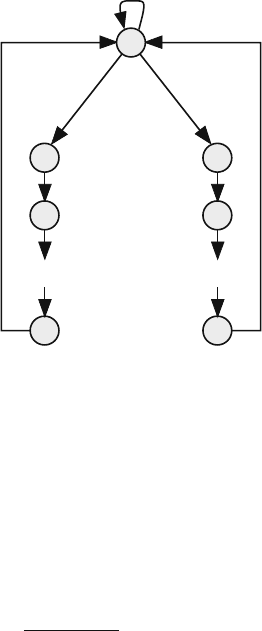
10.7 IEEE 802.11: DCF Function for Ad Hoc Wireless LANs 355
Fig. 10.19 State transition
diagram for the 802.11
channel
y
x
z
Idle
Transmitting
i
t
1
1
Collided
1
111 1
...
1
...
1
t
2
t
n
c
n
c
2
c
1
x = u
w
0
= (1 −a)
N
(10.91)
The channel moves from idle to transmitting state with probability y, which is
the probability that only one user in any of the reservation slots requests a transmis-
sion and all users in the previous slots did not request to access the channel. The
probability y for this event is given by
y = u
1
+u
0
u
1
+u
2
0
u
1
+···+u
w−1
0
u
1
=
u
1
1 −u
w
0
1 −u
0
(10.92)
The channel moves from the idle to the collided state with probability z, which
is the probability that more than one user in any of the reservation slots requests a
transmission and all other users in the previous slots are idle. The probability z for
this event is simply given by
z = 1 −x − y (10.93)
We organize the distribution vector at equilibrium as follows:
s =
s
i
s
t
1
s
t
2
··· s
t
n
s
c
1
s
c
2
··· s
c
n
t
(10.94)
The corresponding state transition matrix of the channel for the case when n = 3
is given by

356 10 Modeling Medium Access Control Protocols
P =
⎡
⎢
⎢
⎢
⎢
⎢
⎢
⎢
⎢
⎣
x 001001
y 000000
0100000
0010000
z 000000
0000100
0000010
⎤
⎥
⎥
⎥
⎥
⎥
⎥
⎥
⎥
⎦
(10.95)
At equilibrium, the distribution vector is obtained by solving the two equations
Ps = s (10.96)
s = 1 (10.97)
The solution to the above two equations is simple:
s =
1
n(1 − x) +1
⎡
⎢
⎢
⎢
⎢
⎢
⎢
⎢
⎢
⎢
⎢
⎢
⎢
⎢
⎢
⎣
1
y
y
.
.
.
y
z
z
.
.
.
z
⎤
⎥
⎥
⎥
⎥
⎥
⎥
⎥
⎥
⎥
⎥
⎥
⎥
⎥
⎥
⎦
(10.98)
When w = 1, the equilibrium distribution vector for IEEE 802.11 above becomes
identical to the equilibrium distribution vector for CSMA/CA in Eq. (10.79).
10.7.3 IEEE 802.11: DCF Protocol Performance
The throughput is given by the equation
Th =
n
i=1
s
t
i
=
ny
n(1 − x) +1
(10.99)
Figure 10.20 shows the throughput of IEEE 802.11 when w = 8, n = 10, and
N = 32. The upper solid line is the throughput of IEEE 802.11/DCF, the lower
solid line is the throughput of CSMA/CA, the dashed line represents the throughput
of slotted ALOHA, and the dotted line represents the throughput of pure ALOHA.
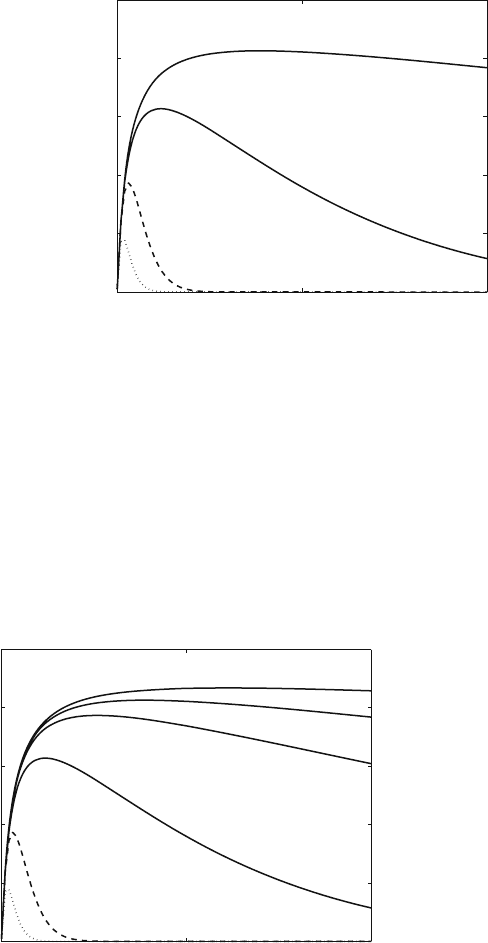
10.7 IEEE 802.11: DCF Function for Ad Hoc Wireless LANs 357
Fig. 10.20 Throughput for
the IEEE 802.11/DCF
protocol versus the average
input traffic when w = 8,
n = 10, and N = 32. The
upper solid line is the
throughput of IEEE
802.11/DCF, the lower solid
line is the throughput of
CSMA/CA, the dashed line
represents the throughput of
slotted ALOHA, and the
dotted line represents the
throughput of pure ALOHA
0 16 32
0
0.2
0.4
0.6
0.8
1
Input traffic
Throughput
The throughput is high due to several factors such as distribution of users among
reservation channels and assuming the wireless medium is error free.
Changing the number of reservation slots has a direct effect on the throughput. To
test this, we selected values of w as 4, 8, and 16. Figure 10.21 shows the throughput
for the IEEE 802.11/DCF protocol versus the average input traffic when n = 10
and N = 32 and w = 4, 8, and 16. Dashed line represents the throughput of
slotted ALOHA, and the dotted line represents the throughput of pure ALOHA.
We note two things from this figure. First, reducing the value of n leads to lesser
throughput since more significant amount of time is spent listening to the carrier.
0 16 32
0
0.2
0.4
0.6
0.8
1
Input traffic
Throughput
w = 16
w
= 8
w = 4
CSMA/CA
Fig. 10.21 Throughput for the IEEE 802.11/DCF protocol versus the average input traffic when
n = 10 and N = 32 and w = 4, 8, and 16. Dashed line represents the throughput of slotted
ALOHA and the dotted line represents the throughput of pure ALOHA
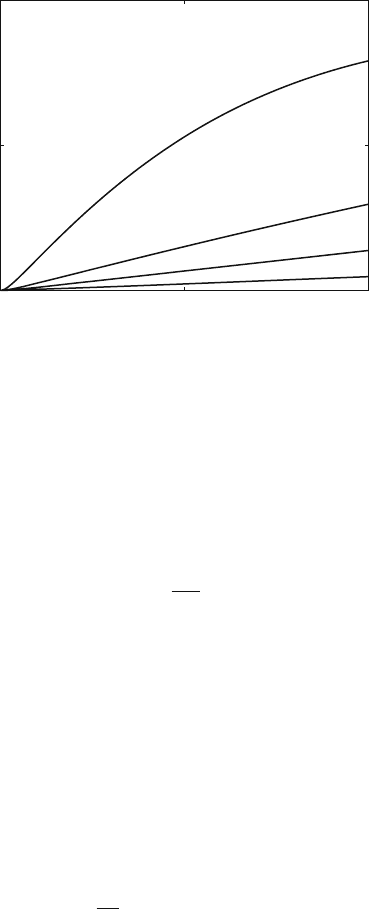
358 10 Modeling Medium Access Control Protocols
0 16 32
0
0.5
1
Input traffic (packets/frame)
Collided probability
CSMA/CA
w
= 16
w
= 8
w
= 4
Fig. 10.22 Probability of collision for the IEEE 802.11/DCF protocol versus the average input
traffic when n = 10 and N = 32 and w = 4, 8, and 16
Second, adoption of reservation slots distributes the user requests among the slots.
This leads to less chance of collisions and more throughput results. To prove this
last point, the collision probability is shown in Fig. 10.22.
The user access probability is given by
p
a
=
Th
Na
(10.100)
Figure 10.23 shows the access probability of IEEE 802.11/DCF when w = 8,
n = 10, and N = 32. The upper solid line is the access probability of IEEE
802.11/DCF, the lower solid line is the access probability of CSMA/CA, the dashed
line represents the access probability of slotted ALOHA, and the dotted line repre-
sents the access probability of pure ALOHA.
The average energy required to transmit a frame is estimated as
E = E
0
∞
i=0
(i +1)(1 − p
a
)
i
p
a
=
E
0
p
a
(10.101)
where E
0
is the energy required to send one frame. In dB, the above equation can
be written as
E =−10 log
10
p
a
dB (10.102)
